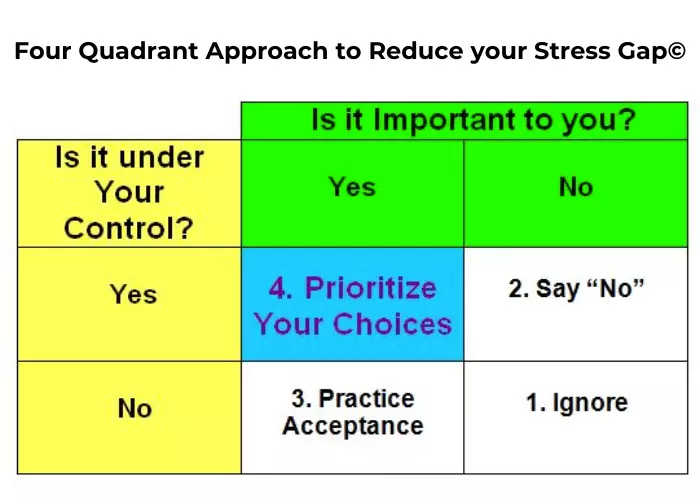Use the Power Quadrant© to Reduce Your Work Stress Level

What is Stress?
One person’s stress is another person’s exciting adventure.
Think of the late Steve Irwin, aka the Crocodile Hunter. He found chasing and wrestling crocodiles exciting and adventuresome, yet I would be very stressed having a crocodile within 50 feet of me if there was not a very large fence between us. Same event – different stress levels.
If stress is not an external phenomenon, then what is it?
Dr. Hans Selye, the ‘Father of Stress’ said, “Stress is the nonspecific response of the body to any demand – real or imagined – made on it.”
The stressor itself is not nearly as important as the meaning and significance we give to the event. There is no such thing as external stress. Anxiety does not “attack”!
Research has shown that work stress has many effects on our health from recurrent infections to frequent headaches and back pain, to depression, asthma, ulcers and even heart attacks.
The good news is, that there is usually a five to ten year delay between chronic stress and physical symptoms.
More people are stressed now than they were twenty years ago:
- We are working longer hours and for less after-tax dollars.
- Burnout at work is averaging over twenty five percent and climbing.
- More than 60% of workers compensation is for work stress, a rarity twenty years ago.
- There are higher expectations on people now. With the advances in technology we are expected to be “on call” for many after work hours which was once used for family or leisure time.
- Our children are exposed to much more now on the World Wide Web than they ever were at younger ages.
- Twenty percent of families are caught in the ‘Sandwich Generation’ – looking after aging parents and our own children.
It’s enough to make you want to scream! Go ahead if that will help lower your stress.
There is a way to get things back under control.
Jump To Section

Earn As You Learn
Earn 25% commission when your network purchase Uplyrn courses or subscribe to our annual membership. It’s the best thing ever. Next to learning,
of course.
Your Stress Gap©
The amount of stress you are experiencing in your life can be represented by a very simple equation. It is equal to the GAP between the Demand or Stressor placed on you and your ability to handle the demand, which I refer to as your Resilience.
This “gap” is your Stress Gap©.
The bigger the gap, the more stress you will feel. So the idea is to either lower the demands or stressors placed upon you in your life or raise your Resilience. How do you do this?
You can categorize almost everything in your life into one of the four quadrants in the table on the right:
- Unimportant (relatively) and out of your control.
- Unimportant and in your control.
- Important and out of your control.
- Important and in your control.
First let’s look at the column of what is not important to you, i.e., boxes 1 and 2.
This is a great way to reduce your Stress Gap© by lowering the Stressors placed upon you.
Referring to Box #1, if it is not important to you and it is out of your control, practice ignoring it. Examples of things that fit in this quadrant include the weather or gossip at work or simply complaining about what’s wrong with everything in your office.
Moving onto Box #2, if it is not important to you yet it is under your control it is very tempting to be drawn into working in this area because it is often easier to do. However, you will find this to be a big time waster that will ultimately lead you away from your goals. Examples of these are checking all of your emails before you start your day or trying to fix a problem that is outside your area of expertise. In the former example, it may be wiser to tackle your number one priority right away and then check your emails after you have given your energy to what is important. In the latter example, if your time would be better spent doing something else, delegate that task to someone who is proficient in that field. Just because you can do it does not mean that you should do it.
As we move our attention to Boxes #3 and #4, if the task is important to you, you have an opportunity to raise your Resilience. If it is important to you but is out of your control (Box #3) practicing acceptance can reduce your stress level. Examples of events that fall into this quadrant include a death in the family, being downsized, suffering abuse at an early age or regret over the past and worry about the future.
Give the best that you can and then trust that what you give out will come back to you. You do not know how that will materialize so release control of the outcome. You can’t control every possible outcome even if you tried.
Practice acceptance of who you are will help lower your Stress Gap©. Besides, the unexpected outcome may turn out to be better for you than what you thought you wanted.
Lastly and perhaps most importantly, you should spend the bulk of your energy in Quadrant #4.
Here, things are important to you and they are under your control. I call this quadrant the
Power Quadrant© because that is where you will get most of your personal power.
This entails getting your life back in balance. It includes refusing to take on too much by prioritizing your time and the activities you want to be involved in.
It means getting back in control of your financial situation and taking the time to choose your life direction.
It’s ironic that many people spend a lot of their time in the first three least important quadrants. They talk about what is wrong with the world, their jobs or their past. They kill time by reading junk emails, listening to gossip or doing things they dislike. And they worry about the future instead of taking action to change it.
Using the four quadrant approach in your life’s plans, you will be able to do more of what you do want. By ignoring or saying “no’ to unimportant issues you will find that you free up valuable time you had previously wasted. By practicing acceptance to those important things out of your control you will be able to focus your energies on what truly matters – the Power Quadrant© where you do have control of important issues in your life.
You can also learn more through my Managing Work Stress online course here.



Leave your thoughts here...
All Comments
Reply